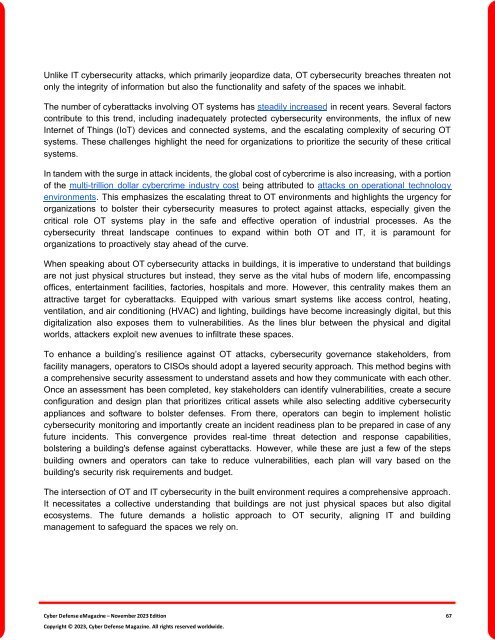The Cyber Defense eMagazine November Edition for 2023
Cyber Defense eMagazine November Edition for 2023 #CDM #CYBERDEFENSEMAG @CyberDefenseMag by @Miliefsky a world-renowned cyber security expert and the Publisher of Cyber Defense Magazine as part of the Cyber Defense Media Group as well as Yan Ross, Editor-in-Chief and many more writers, partners and supporters who make this an awesome publication! 196 page November Edition fully packed with some of our best content. Thank you all and to our readers! OSINT ROCKS! #CDM #CDMG #OSINT #CYBERSECURITY #INFOSEC #BEST #PRACTICES #TIPS #TECHNIQUES
Cyber Defense eMagazine November Edition for 2023 #CDM #CYBERDEFENSEMAG @CyberDefenseMag by @Miliefsky a world-renowned cyber security expert and the Publisher of Cyber Defense Magazine as part of the Cyber Defense Media Group as well as Yan Ross, Editor-in-Chief and many more writers, partners and supporters who make this an awesome publication! 196 page November Edition fully packed with some of our best content. Thank you all and to our readers! OSINT ROCKS! #CDM #CDMG #OSINT #CYBERSECURITY #INFOSEC #BEST #PRACTICES #TIPS #TECHNIQUES
Create successful ePaper yourself
Turn your PDF publications into a flip-book with our unique Google optimized e-Paper software.
Unlike IT cybersecurity attacks, which primarily jeopardize data, OT cybersecurity breaches threaten not<br />
only the integrity of in<strong>for</strong>mation but also the functionality and safety of the spaces we inhabit.<br />
<strong>The</strong> number of cyberattacks involving OT systems has steadily increased in recent years. Several factors<br />
contribute to this trend, including inadequately protected cybersecurity environments, the influx of new<br />
Internet of Things (IoT) devices and connected systems, and the escalating complexity of securing OT<br />
systems. <strong>The</strong>se challenges highlight the need <strong>for</strong> organizations to prioritize the security of these critical<br />
systems.<br />
In tandem with the surge in attack incidents, the global cost of cybercrime is also increasing, with a portion<br />
of the multi-trillion dollar cybercrime industry cost being attributed to attacks on operational technology<br />
environments. This emphasizes the escalating threat to OT environments and highlights the urgency <strong>for</strong><br />
organizations to bolster their cybersecurity measures to protect against attacks, especially given the<br />
critical role OT systems play in the safe and effective operation of industrial processes. As the<br />
cybersecurity threat landscape continues to expand within both OT and IT, it is paramount <strong>for</strong><br />
organizations to proactively stay ahead of the curve.<br />
When speaking about OT cybersecurity attacks in buildings, it is imperative to understand that buildings<br />
are not just physical structures but instead, they serve as the vital hubs of modern life, encompassing<br />
offices, entertainment facilities, factories, hospitals and more. However, this centrality makes them an<br />
attractive target <strong>for</strong> cyberattacks. Equipped with various smart systems like access control, heating,<br />
ventilation, and air conditioning (HVAC) and lighting, buildings have become increasingly digital, but this<br />
digitalization also exposes them to vulnerabilities. As the lines blur between the physical and digital<br />
worlds, attackers exploit new avenues to infiltrate these spaces.<br />
To enhance a building’s resilience against OT attacks, cybersecurity governance stakeholders, from<br />
facility managers, operators to CISOs should adopt a layered security approach. This method begins with<br />
a comprehensive security assessment to understand assets and how they communicate with each other.<br />
Once an assessment has been completed, key stakeholders can identify vulnerabilities, create a secure<br />
configuration and design plan that prioritizes critical assets while also selecting additive cybersecurity<br />
appliances and software to bolster defenses. From there, operators can begin to implement holistic<br />
cybersecurity monitoring and importantly create an incident readiness plan to be prepared in case of any<br />
future incidents. This convergence provides real-time threat detection and response capabilities,<br />
bolstering a building's defense against cyberattacks. However, while these are just a few of the steps<br />
building owners and operators can take to reduce vulnerabilities, each plan will vary based on the<br />
building's security risk requirements and budget.<br />
<strong>The</strong> intersection of OT and IT cybersecurity in the built environment requires a comprehensive approach.<br />
It necessitates a collective understanding that buildings are not just physical spaces but also digital<br />
ecosystems. <strong>The</strong> future demands a holistic approach to OT security, aligning IT and building<br />
management to safeguard the spaces we rely on.<br />
<strong>Cyber</strong> <strong>Defense</strong> <strong>eMagazine</strong> – <strong>November</strong> <strong>2023</strong> <strong>Edition</strong> 67<br />
Copyright © <strong>2023</strong>, <strong>Cyber</strong> <strong>Defense</strong> Magazine. All rights reserved worldwide.

















